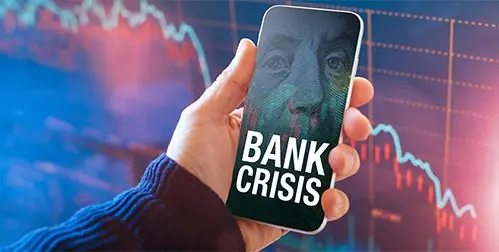- In response to political instability reaching new heights, investors are flocking to gold
- The move to gold is a “flight to safety” – preserving wealth by moving from risky securities to safe haven physical precious metals
- The U.S. Presidential election is likely to increase volatility, and in turn, raise the price of gold
Gold as Hedge Against Political Uncertainty
In a world reeling with political turmoil, gold is once again proving itself to be an unrivaled safe haven asset. Throughout history, gold has been a reliable store of value. As uncertainty increases, so will the demand for the precious metal. In today’s current unrest, gold prices are trading at new highs above $2,400 an ounce. Gold’s inherent economic traits make it a wise choice for those seeking insurance from the severe consequences of political chaos.
A “flight to safety” is at the core of gold’s demand. “Flight to safety” in investing refers to the behavior of investors moving their capital from riskier assets to safer, more stable investments during times of economic uncertainty or market volatility. This typically involves selling off stocks, high-yield bonds, or other speculative investments in favor of gold. The primary goal is to preserve wealth rather than seek high returns.

Reasons Investors Turn to Gold During Political Instability
Investors gravitate towards gold during times of political turmoil for several reasons. Primarily, gold serves as a preservation of wealth. Political instability often leads to higher inflation, devaluing assets. Currency can lose value as people lose confidence in the government, its economic policies, and future economic conditions. Inflation can result from increased government spending to address crises or maintain power. And as inflation rises, capital flight further weakens the currency, creating a vicious cycle of economic instability.
Unlike paper currencies or other assets, gold is a hedge against inflation. It retains its intrinsic value over time. The high liquidity of gold also adds to its appeal. It allows investors to quickly convert their holdings into cash if necessary. Additionally, gold provides diversification benefits, reducing the overall risk in an investment portfolio. Gold’s lack of credit risk and negative correlation to risk asset secures its role as a crisis hedge.
Market Dynamics
Gold and uncertainty are strongly linked. Studies have shown that during global crises, when things are most uncertain, gold prices go up. But even as these tension rise, the riskiness of gold as an investment stays stable. The flight to safety does not make gold markets more volatile. As a matter of fact, when it comes to safe havens, gold has consistently outperformed U.S. government bonds since the 1990s. 1
Historical Examples
During the subprime mortgage crisis and Great Recession, gold prices climbed over 119% from October 2008 to August 2011.2 Similarly, gold jumped 22% after the Brexit referendum was passed. Prices also surged upward during the 2019 U.S.-China trade tensions. 3,4
Risk Metrics
The Geopolitical Risk (GPR) index measures both actual and perceived geopolitical tension. A study by the World Gold Organization found that gold responds to elevated geopolitical risk when all other variables are removed. They discovered that an increase in the GPR index by 100 units positively impacts gold’s return by 2.5%. Gold spiked alongside the GPR following the Russia invasion of Ukraine and the conflict in the Middle East. Even as the GPR dropped back down, gold prices remained high.5
The Partisan Conflict Index represents the degree of political disagreement among U.S. politicians at the federal level. It is run by the Federal Reserve Bank of Philadelphia. It is significant as a measure of economic and political uncertainty. The index and gold prices often show an inverse relationship: when partisan conflict increases, gold prices tend to rise. When it decreases, gold prices often fall. The Fed explains that this relationship exists because higher partisan conflict creates political uncertainty. And this prompts investors to seek “safe haven” assets like gold, thus increasing demand and driving up its price.6
Gold and Elections
Presidential elections often create market volatility. Historically, U.S. election outcomes influence gold prices. After Democratic wins, gold typically rises, while Republican wins usually lead to a decline. Gold prices tend to increase following Democratic victories due to expectations of increased fiscal spending and loose monetary policy. Investors associate these with potential currency debasement. The 2020 U.S. presidential election contributed to gold prices increasing by about 25% in the year leading up to the November election. Gold hit a then all-time high of over $2,000 in August 2020. 7
 8
8
Unstable Future Outlook
The current state of political instability looks likely to continue. A recent Reuters poll found that 80% of American voters believe the country is spiraling out of control. Eighty four percent are concerned that extremists will commit acts of violence after the election. Few people condone violence, with just 5% of respondents saying it is an acceptable means to achieve a political goal.9
This prevailing political and economic instability continues to drive the demand for gold as a safe haven asset. Physical precious metals, especially in a Gold IRA, can shield the value of retirement funds from the impact of social chaos. To protect your finances from an uncertain future, contact us today at 800-462-0071.
Notes:
1. https://www.economicsobservatory.com/is-gold-a-safe-haven-for-investors
2. https://www.deseret.com/2023/11/8/23952266/presidential-elections-republican-democrat-effect-price-gold/
3. https://www.theguardian.com/business/2016/jun/24/gold-jumps-22-percent-eu-referendum-vote
4. https://www.cnbc.com/2019/05/10/gold-market-us-china-trade-talks-tariff-threats-in-focus.html
5. https://www.gold.org/goldhub/gold-focus/2023/10/you-asked-we-answered-whats-impact-of-geopolitics-on-gold
6. https://www.gold.org/goldhub/gold-focus/2023/10/you-asked-we-answered-whats-impact-of-geopolitics-on-gold
7. https://www.royalmint.com/invest/discover/gold-news/us-elections/
8. https://kinesis.money/blog/gold/us-presidential-election-affect-price-gold/
9. https://www.reuters.com/world/us/four-five-americans-fear-country-is-sliding-into-chaos-reutersipsos-poll-finds-2024-07-16/



 4
4


 4
4

 1
1


 4
4



 5
5
